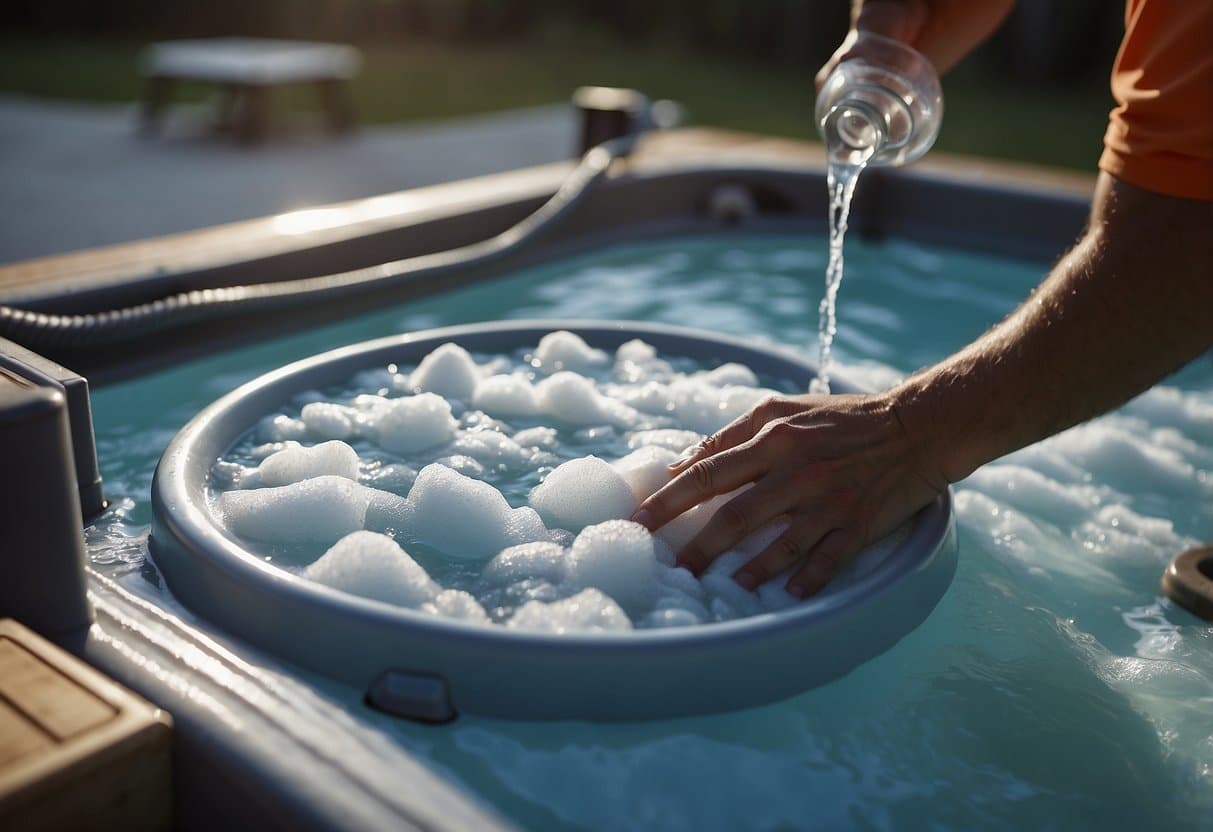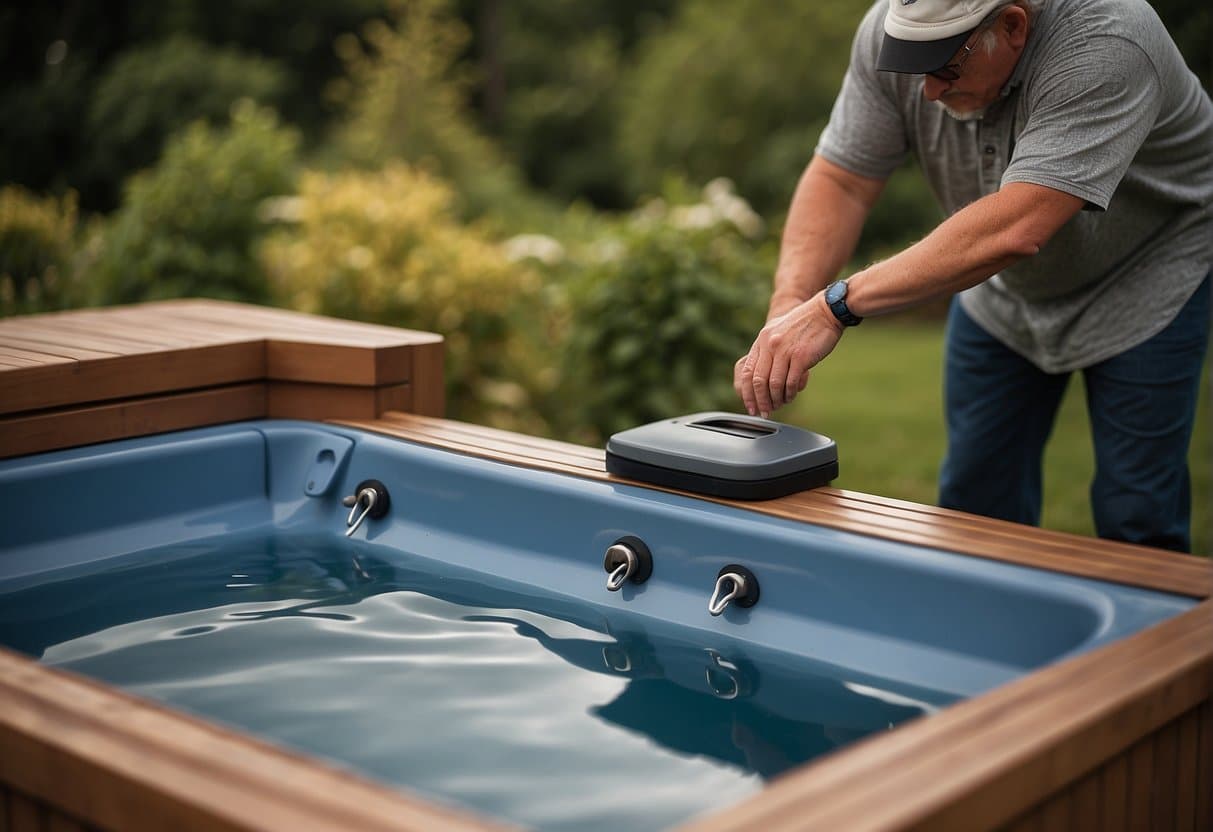Foam in a hot tub can be a bothersome issue for many owners. Foam forms when the water is contaminated with personal care products, oils, or detergents. These contaminants react with the water, causing bubbles and foam to appear on the surface. So how do you get rid of foamy water in the hot tub without draining it? The solution is easier than you think.
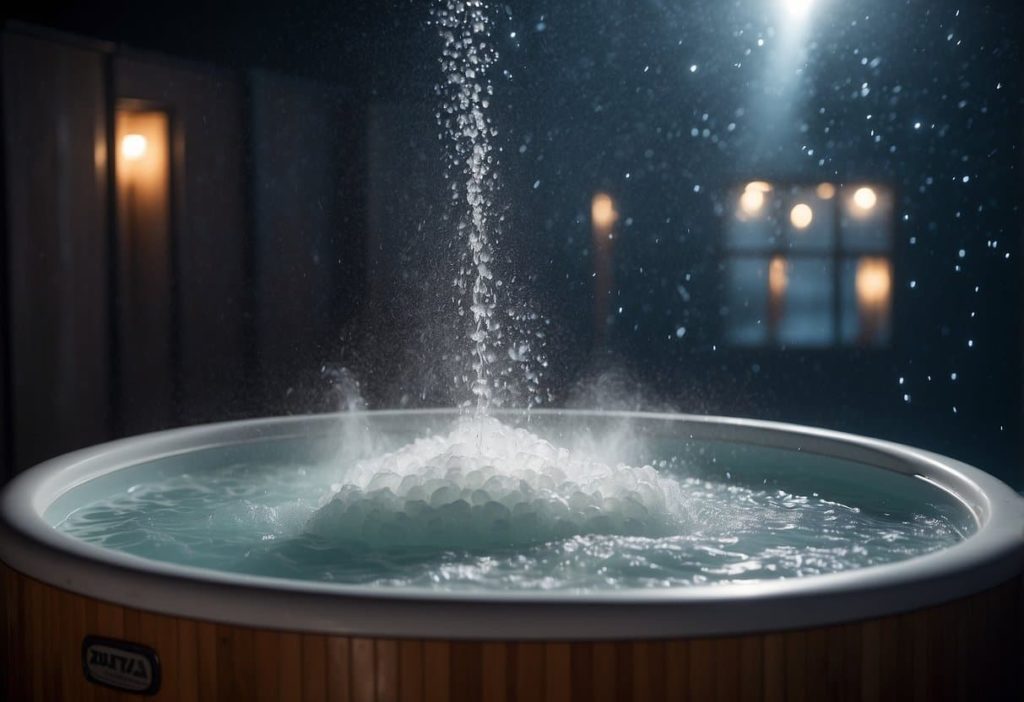
Not only does foamy water look uninviting, but it can also signal that your hot tub needs cleaning. Proper water maintenance is essential to keep foam at bay. Regularly changing the water and using the right chemicals can help maintain a clean and inviting hot tub.
Ignoring foam can lead to larger problems, such as clogged filters and damaged jets. By addressing the cause quickly and effectively, one can ensure their hot tub stays in top condition for relaxation and enjoyment.
Understanding Hot Tub Foam
Hot tub foam forms for various reasons, often influenced by external substances and chemical imbalances. It’s common to encounter foam in hot tubs due to specific ingredients in products we use daily.
Causes of Hot Tub Foam
Foam in hot tubs is usually caused by the introduction of surfactants. These are substances that reduce the surface tension of water, allowing bubbles to form. Common surfactants are found in personal care products like soap, lotion, and shampoo.
Personal care products such as body lotions and shampoos can easily wash off into the hot tub.
Laundry detergents on swimwear can also contribute to foam. Rinse swimwear thoroughly before entering the hot tub.
The Role of Surfactants
Surfactants are active agents found in many household items. They help create foam by trapping air into bubbles.
Products that contain surfactants include:
- Bubble baths and soaps
- Shampoos and conditioners
- Body lotions and creams
Using these products before entering a hot tub can cause surfactants to rinse into the water, resulting in foamy residue.
Chemical Imbalance and Water Chemistry
Foam can also result from chemical imbalances in your hot tub water.
Water chemistry plays a vital role. If the levels of pH, alkalinity, or sanitizers like chlorine are incorrect, it can lead to foam formation. Keeping the water balanced helps prevent this issue.
Regular water testing and using the right chemicals are key. Ensure chlorine or bromine levels are adequate to minimize foam. Keep pH levels between 7.2 and 7.8 for optimal results.
Water Testing and Chemical Levels
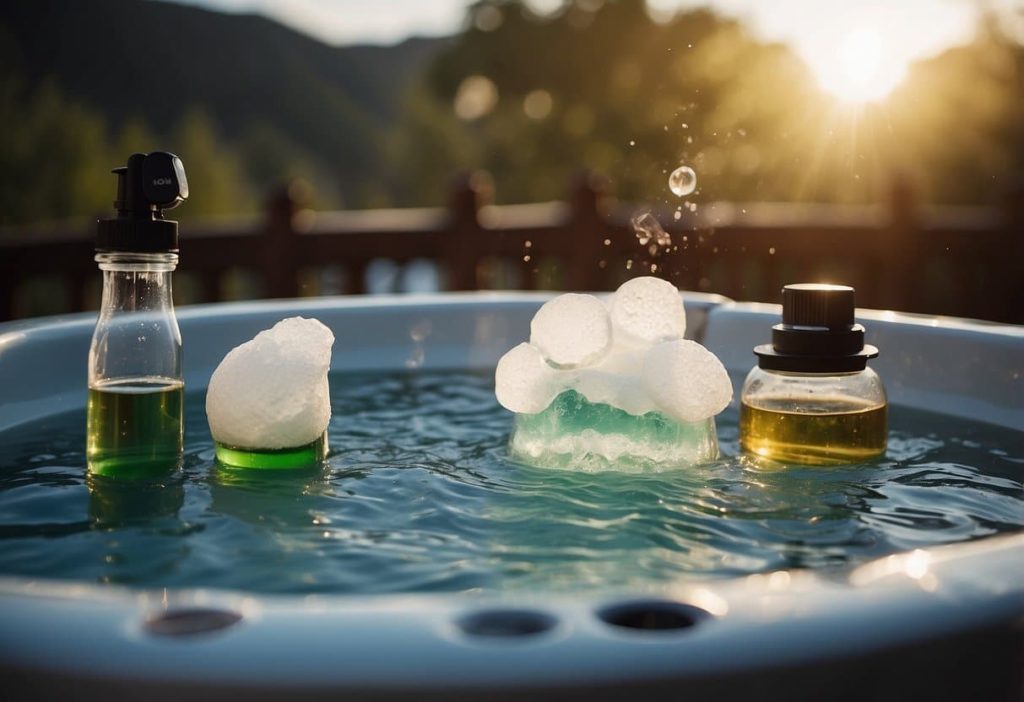
Maintaining the right chemical balance in your hot tub ensures clean, safe, and comfortable water. Key factors include regular water testing and adjusting pH, alkalinity, and calcium hardness levels.
Importance of Regular Water Testing
Regular water testing is essential to keep hot tub water balanced. It helps prevent skin irritation and equipment damage. Users should test water at least twice a week using test strips. These strips measure pH levels, total alkalinity, and sanitizer levels. Immediate adjustments based on test results keep your hot tub safe and pleasant. Neglecting water testing can lead to cloudy water, foam, and scale buildup.
Assessing pH and Alkalinity Levels
pH levels in a hot tub should stay between 7.2 and 7.8. A low pH can cause corrosion, while a high pH can lead to scale formation and decrease sanitizer effectiveness. Use pH increaser or pH decreaser to adjust as needed.
Total alkalinity acts as a buffer for pH and should be within 80-120 ppm. Low alkalinity causes erratic pH levels, and high alkalinity makes it hard to adjust pH. Use specific chemicals to raise or lower alkalinity based on your test strip results.
Managing Calcium Hardness
Calcium hardness levels should be between 150-250 ppm. Low levels can cause foamy water and equipment corrosion. High levels lead to calcium mineral buildup and cloudy water. Regular testing helps maintain these levels. Add a calcium hardness increaser if levels are low. If levels are high, dilute the water or use a specialized treatment to bring it back to the desired range. Proper management prevents foam and extends the life of hot tub components.
Preventing Hot Tub Foam
Keeping a hot tub free of foam involves addressing personal care residues, maintaining the equipment, and balancing the water’s chemistry.
Cleanliness and Personal Care Residues
Foam often comes from leftover products people use. Lotions, soaps, and hair products can get mixed with hot tub water. These residues create foam when the jets are turned on.
Before entering the hot tub, individuals should shower to remove any lotions, oils, or soaps from their skin. Wearing a swim cap can also help prevent hair products from entering the water.
Encouraging guests to rinse off before using the hot tub can make a big difference. Posting reminders near the hot tub area can be beneficial.
Proper Hot Tub Maintenance
Regular maintenance is key to preventing foam. Filters should be cleaned monthly to remove any debris or residues. Draining and refilling the hot tub every three to four months helps keep the water fresh.
Checking for any clogs or buildup in the hot tub’s system is crucial. Regularly inspecting the jets and pipes ensures everything is working correctly.
Using a cover when the hot tub is not in use can prevent debris from entering the water. This practice also reduces the evaporation rate, maintaining the water level and quality.
Balancing Water Chemistry
Unbalanced water chemistry can cause foam. Ensuring the right levels of pH, alkalinity, and sanitizer is crucial. pH levels should be between 7.2 and 7.8. Alkalinity should be between 80-120 ppm.
Using test strips or kits, check the water chemistry at least once a week. Adjust chemicals as needed to maintain balance.
Shock treatments can be used to clear any lingering contaminants. If foam persists, consider using a defoamer as a temporary solution.
Knowing the chemical levels and adjusting them as needed prevents foam and keeps the water safe and clean.
Troubleshooting and Solutions
Clearing foam in a hot tub involves cleaning, using anti-foam chemicals, or sometimes draining and refilling the tub. These solutions help eliminate contaminants, cloudy water, and persistent foam problems.
Effective Cleaning Methods
Regular cleaning is crucial to prevent foam in a hot tub. Clean the filter every 2-3 weeks to remove contaminants. Use a line flush to clean out the plumbing system every 3-4 months. This helps remove any built-up oils and lotions that can cause foaming.
Wipe down the hot tub surfaces with a mild, non-abrasive cleaner. This keeps grime and buildup at bay. Keep a regular cleaning schedule to ensure your water stays clean and clear, preventing foam and cloudy water.
Using Anti-Foam Chemicals
Anti-foam chemicals are effective for quick foam removal. Add hot tub defoamer directly to the water as per the manufacturer’s instructions. These chemicals break down the surface tension of the water, causing foam to dissipate.
For ongoing foam problems, use a hot tub sanitizer regularly. Sanitizers kill bacteria and prevent contaminants from accumulating. Consider using an enzyme-based cleaner which can break down oils and lotions that may not be fully removed by traditional cleaning methods.
When to Drain and Refill
Sometimes, draining and refilling is necessary. If foam remains after cleaning and using chemicals, it could indicate that the water is too saturated with chemicals and contaminants. Drain the hot tub every 3-4 months to keep the water fresh.
Before refilling, clean the entire hot tub, including the filter and jets. This ensures there are no lingering contaminants. Once refilled, balance the water chemistry with the appropriate sanitizers and chemicals.
By following these steps, you can maintain clear, foam-free water in your hot tub. Regular maintenance and proper chemical use are key to solving foam problems.
Ensuring Optimal Water Health

Maintaining healthy water in a hot tub is crucial. Key practices involve systematic water circulation, managing chemicals wisely, and preventing biofilm buildup. These measures ensure the tub remains a relaxing and safe environment.
Systematic Water Circulation
Water circulation is vital for even distribution of chemicals. Effective circulation helps prevent stagnation, which can lead to bacteria growth. Running the pump for at least 20 minutes a day keeps the water moving. Use filters to trap debris and replace them regularly.
- Clean filters monthly with white vinegar.
- Run the jets daily.
Good circulation also assists in removing contaminants and keeping the water clear.
Hot Tub Chemical Best Practices
Balancing hot tub chemicals is key. Sanitizers like chlorine and bromine kill harmful bacteria. Regular water testing helps maintain ideal levels.
Chemical Tips:
- Test water 2-3 times a week.
- Use an alkalinity increaser if needed.
- Add baking soda to adjust pH.
Proper management of water hardness ensures the water isn’t too harsh on the skin or equipment.
Preventing Biofilm Buildup
Biofilm buildup can clog systems and harbour bacteria. Biofilms form when organic matter sticks to surfaces. Regular cleaning and shocking the water can prevent these issues.
Preventive Measures:
- Use hot tub-specific cleaners.
- Shock the water with chlorine weekly.
- Add vinegar to the water during cleaning.
Keeping the hot tub covered when not in use can also reduce the risk of contaminants entering and forming biofilms.
Long-Term Maintenance Strategies
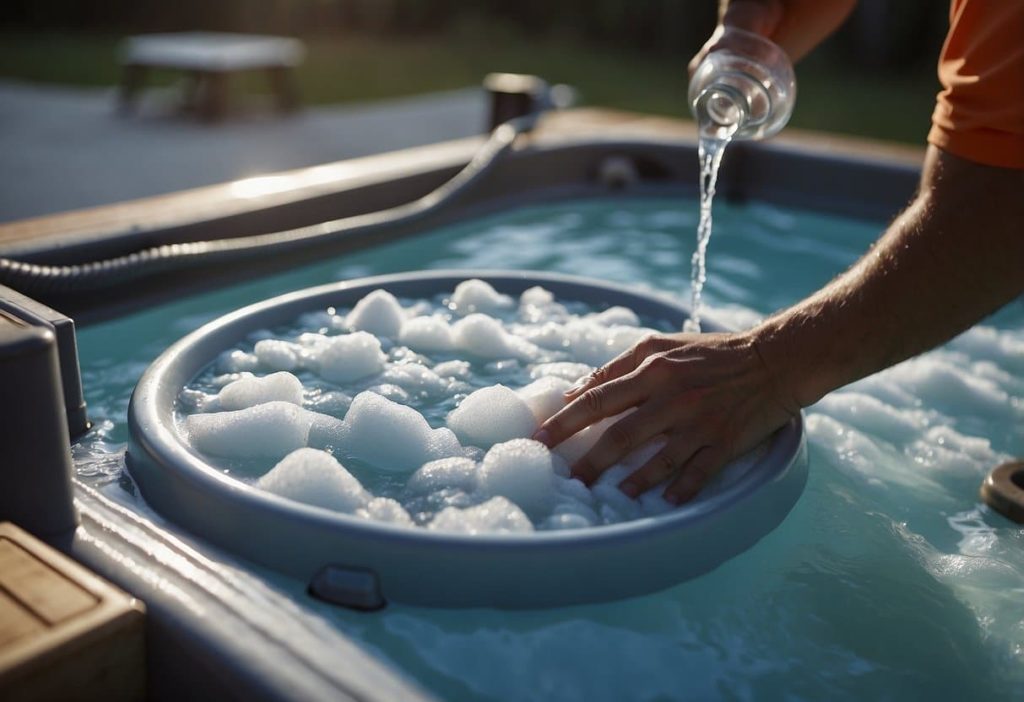
Regular maintenance is key for hot tubs. Consistent cleaning helps prevent hot tub foam and keeps it in top shape.
Weekly Tasks:
- Skim the surface to remove debris.
- Clean the filter with water.
- Check water levels.
Monthly Tasks:
- Use a filter cleaner to deep clean the filter.
- Check and balance chemicals.
- Inspect the cover and clean it.
Every 3-4 Months:
- Drain and refill the hot tub.
- Use a surface cleaner on the shell.
- Clean all accessories.
Tips to Prevent Foam:
- Shower Before Use: Removes oils and lotions.
- Limit Soap Residue: Rinse swimsuits well.
- Balance Chemicals: Ensure proper pH and sanitizer levels.
Following these steps helps get rid of hot tub foam and keeps the water clear.
Frequently Asked Questions
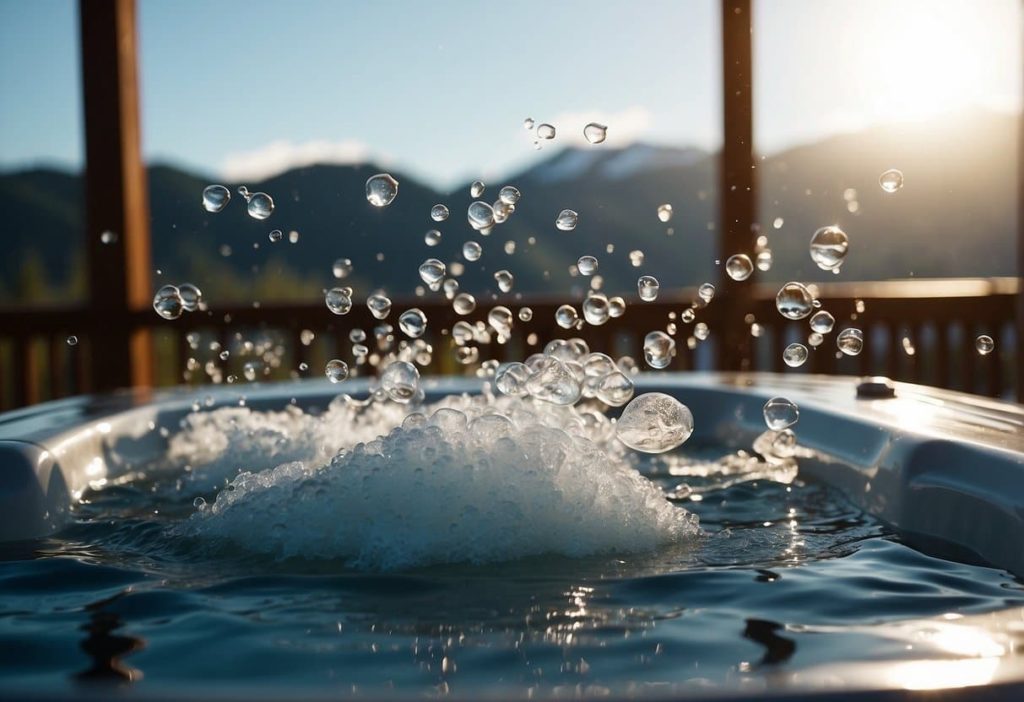
Learn why your hot tub foams, how to reduce it, and the health implications. Discover natural methods, check pH levels, and manage foam after shocking your hot tub.
Why does my hot tub foam when the jets are on?
Foam forms when there are high levels of organic materials like lotions, oils, and soaps in the water. These substances create bubbles when mixed with the air from the jets. The bubbles then surface and create foam in your hot tub.
How can I reduce the amount of foam in my hot tub?
Regularly clean the filters every three to four months to keep the water cleaner. Regularly change the water every three to four months to get rid of what the filters can’t clean. Encourage users to rinse off before entering to keep lotions and oils out of the water.
Can hot tubs cause health issues?
Using a foamy hot tub can lead to skin irritation or infections. Foam can trap bacteria and other contaminants, which might not be thoroughly filtered or sanitized. Biofilm becomes more of a risk to health the longer left untreated or cleaned.
Are there natural methods to eliminate foam in a hot tub?
Yes, regular maintenance and water balance can naturally reduce foam. Use vinegar or baking soda to clean the tub, and ensure everyone rinses off before use. Cleaning your filter regularly can ensure the water stays cleaner.
Could the pH levels in my hot tub be causing excess foaming?
Yes, incorrect pH levels can contribute to foaming. Keep the pH between 7.2 and 7.8 to maintain water balance and help prevent foam. You should be testing your water on a regular basis for optimum water conditions.
What steps should I take after shocking my hot tub to avoid foam?
After shocking, run the jets to help distribute the chemicals. Check and adjust the pH levels, and remove any leftover debris or contaminants to prevent foam buildup.

